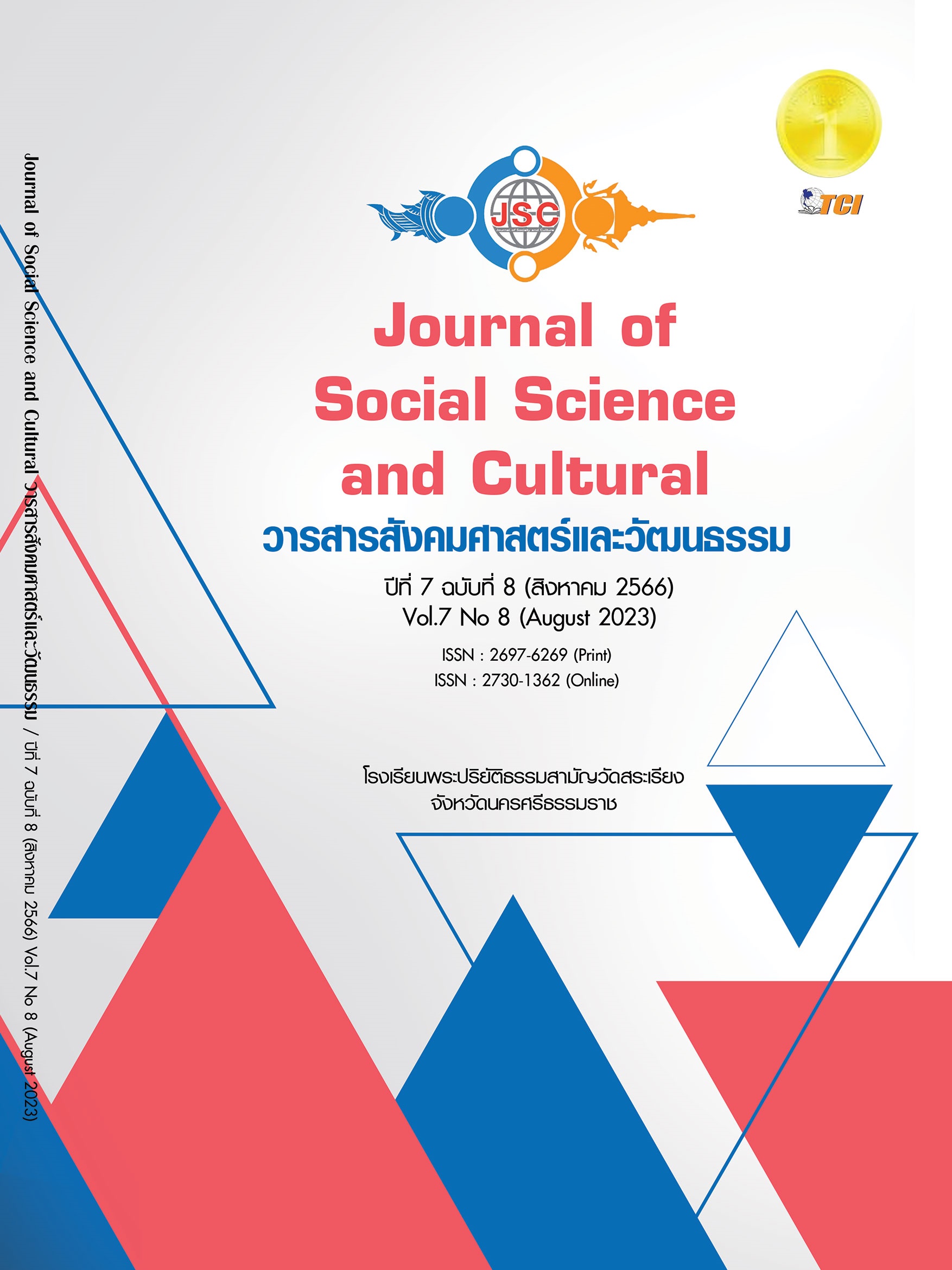THE FACTORS PREDICTING HEALTHCARE BEHAVIORS IN DEALING WITH PATIENTS WITH STAGE 3 PROGRESSIVE CHRONIC KIDNEY DISEASE
Main Article Content
Abstract
The purpose of this research was to study the factors predicting healthcare behaviors in order to slow down the decline of kidney function in patients with stage 3 chronic kidney disease that were receiving treatment at the outpatient clinic of Krathumbaen Hospital in Thailand. A sample of 116 people was selected according to the specified criteria by using the G* Power program. The research tools consisted of the following: 1) a personal data questionnaire; 2) a perception of health questionnaire; 3) a healthcare behavior knowledge assessment questionnaire; and 4) a healthcare behavior questionnaire for slowing the decline of the kidneys in stage 3 chronic kidney disease patients. Data were analyzed using descriptive statistics, Pearson’ s product correlation coefficient, and stepwise multiple regression analysis. The results showed that all of factors able to predictive the healthcare behaviors for slowing down the decline of their kidney function (R2 = .519, F = 40.275, p<.001). There was a total of three factors as follows: 1) perceived severity of the disease (β = .372, p<.001); 2) perceived barriers to behavioral practice for slowing renal impairment (β = -.308, p< .001); and 3) knowledge of healthcare behaviors for slowing down the decline of kidneys function (β = .321, p<.001). These were positively correlated with the healthcare behaviors for slowing down the decline of the kidney function of patients with stage 3 chronic kidney disease (r = .720). Therefore, the factors of perceived severity of the disease, perceived barriers to behavioral practice for slowing renal impairment, and knowledge of healthcare behaviors for slowing down the decline of kidneys function should be taken into account. Used to plan activities and create a health care program to help patients adjust health care behaviors to slow down the deterioration of the kidneys.
Article Details
References
กองโรคไม่ติดต่อ กรมควบคุมโรค. (2565). ระบาดวิทยาและการทบทวนมาตรการการป้องกันโรคไตเรื้อรัง. เรียกใช้เมื่อ 23 เมษายน 2566 จาก https://ddc.moph.go.th/uploads/publish/1308820220905025852.pdf
กันตพร ยอดไชย. (2563). ผู้ป่วยโรคไตเรื้อรัง: การพยาบาลและการจัดการอาการ. (พิมพ์ครั้งที่ 2). สงขลา: บริษัทนีโอพ้อยท์ (1995) จำกัด.
จรีรัตน์ สุทธิพัฒนางกูร, และรัตน์ศิริ ทาโด. (2560). ปัจจัยทำนายพฤติกรรมการป้องกันโรคหลอดเลือดหัวใจของบุคลากรมหาวิทยาลัยในกำกับของรัฐ กรุงเทพมหานคร. วารสารพยาบาลโรคหัวใจและทรวงอก, 28(2), 111-125.
ชุติมา สร้อยนาค และคณะ. (2561). การศึกษาแบบแผนความเชื่อด้านสุขภาพและความเสี่ยงการเกิดโรคเบาหวานชนิดที่ 2 ของมุสลิมวัยทำงาน. วารสารพยาบาลทหารบก, 19(ฉบับพิเศษ), 267-277.
ชูศรี วงศ์รัตนะ. (2560). เทคนิคการสร้างเครื่องมือวิจัย : แนวทางการนำไปใช้อย่างมืออาชีพ. กรุงเทพมหานคร: อมรการพิมพ์.
ฐปรัตน์ รักษ์ภาณุสิทธิ์ และคณะ. (2561). ปัจจัยที่มีความสัมพันธ์ต่อพฤติกรรมสร้างเสริมสุขภาพของนักศึกษามหาวิทยาลัยสงขลานครินทร์ วิทยาเขตปัตตานี. วารสารวิทยบริการ มหาวิทยาลัยสงขลานครินทร์, 29(3), 170-178.
ดวงหทัย แสงสว่าง และคณะ. (2561). ปัจจัยที่มีผลต่อพฤติกรรมการลดระดับน้ำตาลในเลือดของผู้ป่วยโรคเบาหวาน โรงพยาบาลส่งเสริมสุขภาพตำบลบางปูใหม่ จังหวัดสมุทรปราการ. วารสารวไลยลงกรณ์(มนุษยศาสตร์และสังคมศาสตร์, 8(1), 103-117.
นิภาดา วรโพธิ์. (2563). ปัจจัยที่มีผลต่อพฤติกรรมการป้องกันภาวะแทรกซ้อนทางไตของผู้ป่วยเบาหวาน ในอำเภอทัพทัน จังหวัดอุทัยธานี. อุทัยธานี : มหาวิทยาลัยนเรศวร.
ประนอม กาญจนวณิชย์. (2564). ปัจจัยที่มีผลต่อพฤติกรรมการดูแลตนเองเพื่อป้องกันโรคไม่ติดต่อเรื้อรังของอาสาสมัครสาธารณสุขประจำหมู่บ้าน จังหวัดสุพรรณบุรี. วารสารสาธารณสุขมูลฐาน ภาคตะวันออกเฉียงเหนือ, 36(2), 20-33.
ปิ่นแก้ว กล้ายประยงค์. (2550). ประสิทธิผลของโปรแกรมสุขศึกษาในการสร้างเสริมพฤติกรรมการปฏิบัติตัวเพื่อชะลอการเสื่อมของไตเข้าสู่ไตเรื้อรังระยะสุดท้าย ในผู้ป่วยไตเรื้อรังระยะที่ 3 และ 4 ที่แผนกผู้ป่วยนอก อายุรกรรมโรคไต โรงพยาบาลรามาธิบดี. ใน วิทยานิพนธ์วิทยาศาสตรมหาบัณฑิต สาขาสุขศึกษา. มหาวิทยาลัยเกษตรศาสตร์.
พรศิริ พันธสี และกาญจนา ศรีสวัสดิ์. (2563). ความสัมพันธ์ระหว่างความเชื่อด้านสุขภาพกับพฤติกรรมสุขภาพตามหลัก 3อ.2ส. ของผู้สูงอายุ สมาคมแต้จิ๋วแห่งประเทศไทย แขวงทุ่งวัดดอน เขตสาทร กรุงเทพมหานคร. วารสารสุขภาพกับการจัดการสุขภาพ, 6(1), 45-57.
พิชญา กุศลารักษ์ และดาวชมพู นาคะวิโร. (2555). การศึกษาความเที่ยงตรงของแบบทดสอบ Mini-Cog ในผู้ป่วยโรคสมองเสื่อมชาวไทย. รามาธิบดีเวชสาร, 35(4),265-271.
วรารัตน์ จันทร์นุ่ม, และคณะ. (2564). ปัจจัยทำนายพฤติกรรมการชะลอการสูญเสียหน้าที่ของไตในผู้เป็นเบาหวานในจังหวัดชลบุรี. วารสารคณะพยาบาลศาสตร์มหาวิทยาลัยบูรพา, 29(1), 44-55.
ศิริวรรณ พายพัตร, และคณะ. (2563). ความสัมพันธ์ระหว่างความรู้ และการรับรู้สมรรถนะแห่งตนกับพฤติกรรมการจัดการตนเองในผู้ป่วยโรคไตเรื้อรัง. วารสารการพยาบาลและสุขภาพ สสอท, 3(2), 22-36.
สมฤดี บัวป้อม. (2565). ความรู้ การรับรู้ด้านสุขภาพ และพฤติกรรมการดูแลสุขภาพของตนเองในกลุ่มที่มีปัจจัยเสี่ยงโรคเบาหวานที่มีอายุ 35 ปีขึ้นไป ในเขตเทศบาลเมืองสุโขทัยธานี จังหวัดสุโขทัย. Health science clinical research, 37(1), 83-95.
สมาคมโรคไตแห่งประเทศไทย. (2563). Thailand Renal Replacement Therapy year 2020. เรียกใช้เมื่อ 23 เมษายน 2566 จาก https://www.nephrothai.org/wp-content/uploads/2022/06/Final-TRT-report-2020.pdf
สุนิสา สีผม และคณะ. (2557). ผลของโปรแกรมการจัดการตนเองเพื่อการชะลอความเสื่อมของไตต่อความรู้ พฤติกรรมสุขภาพและระดับความดันโลหิต. วารสารพยาบาลโรคหัวใจและทรวงอก, 25(1), 17-31.
Becker, M. H. (1974). The health belief model and sick role behavior. Health Education Monographs, 2(4), 409-419.
Rosenstock, I. M. (1974). The Health Belief Model and Preventive Health Behavior. Health Education Monographs, 2(4), 354-386.
Strecher, V. J. et al. (1997). Health behavior and health education: theory, research, and practice. USA: John Wiley & Sons.


